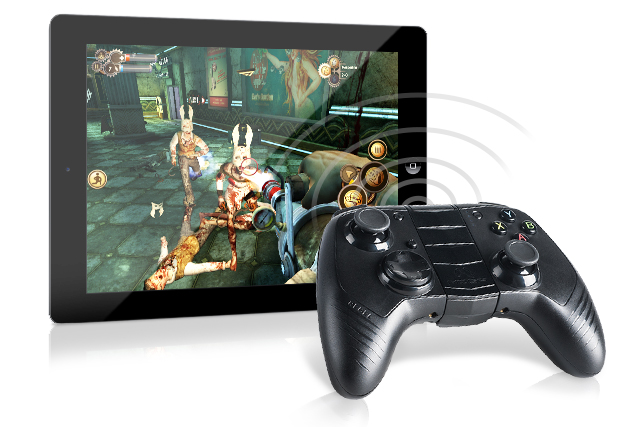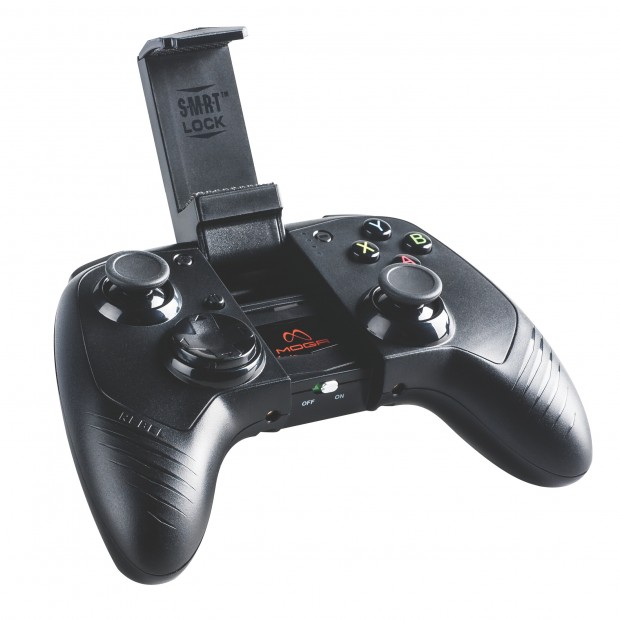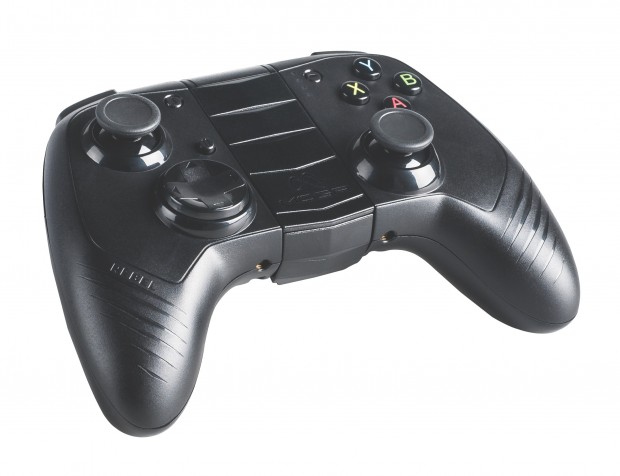 It’s been about a year that we’ve been living in a world of MFi controllers, but for a variety of reasons official controller support on iOS hasn’t been the massive hit everyone expected it to be. While a few decent controllers have been released, none of them have been perfect or particularly “must have", and they all feel expensive compared to controllers on other gaming platforms.
It’s been about a year that we’ve been living in a world of MFi controllers, but for a variety of reasons official controller support on iOS hasn’t been the massive hit everyone expected it to be. While a few decent controllers have been released, none of them have been perfect or particularly “must have", and they all feel expensive compared to controllers on other gaming platforms.
To quickly summarize the controllers that are currently available, the MOGA Ace Power was ok, but its slide-apart mechanism was kind of janky and it didn’t work with iPads. The Logitech Powershell was ok as well, but it was just the “Standard" MFi design, not the “Extended" one, which meant it lacked dual analog sticks and triggers. It also didn’t work with the iPad. The Steel Series Stratus is the best of the bunch, connecting via Bluetooth so it worked with iPhones and iPads, but its incredibly tiny size didn’t work for some gamers.
Today MOGA is trying their hand at a full-sized console-style MFi controller with the release of the Rebel. It connects via Bluetooth and features a swing-out arm for holding iPhone and iPod touch devices, and that even includes both of the larger iPhone 6 models. After spending significant time playing with the Rebel over this past week, I feel largely the same as I did in my initial impressions. The Rebel has some flaws, but compared to its competition it’s head and shoulders above the rest. Most importantly, the Rebel is an MFi controller that I actually enjoy using, and will definitely be using a lot when gaming on my iOS devices.
First, let’s cover the build quality, something that’s been pretty hit and miss with previous MFi controllers. The Rebel is an incredibly solid-feeling piece of hardware, but like other MFi controllers, it still feels a bit too lightweight and plasticky. It doesn’t feel cheap though, but it also doesn’t feel like something that should cost 80 dollars. However, the Rebel feels good in my hands and doesn’t feel like it will break down with normal use and abuse, though I wouldn’t go dropping it or anything. The swing-out arm, the only major moveable part on the controller, feels especially sturdy, which is a far cry from the slide-out mechanism of MOGA’s Ace Power, which was floppy and probably had too many moving parts for its own good. Overall, the Rebel doesn’t feel quite as high quality as a 1st-party controller from Microsoft, Nintendo or Sony, but it’s just a notch or two below those, and still feels like a nice piece of kit.
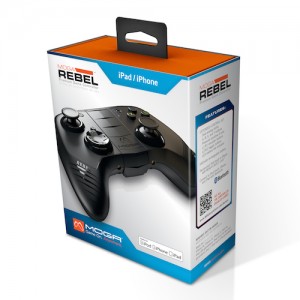 As per Apple’s MFi requirements, every button and even the d-pad on the Rebel is pressure sensitive. There aren’t really any games that take advantage of that feature, but it’s there just in case. The buttons are nice and clicky, and the dual analog sticks feel good in use, though they’re just ever so slightly looser than what I’d prefer. The d-pad is kind of a mess, since it’s one solid circular piece with sort of a bowl shape, also due to Apple’s requirement. Surprisingly though, the d-pad works quite well. I tested it out with fighting games like King of Fighters ’97/’98 and Kinetic Damage, and it holds up really well. You’d think that due to its shape you’d constantly be accidentally pressing diagonal directions when you didn’t want to, but I never encountered that problem. I’d prefer a normal plus-shaped d-pad, but the circular d-pad on the Rebel is much more useable than I thought it would be.
As per Apple’s MFi requirements, every button and even the d-pad on the Rebel is pressure sensitive. There aren’t really any games that take advantage of that feature, but it’s there just in case. The buttons are nice and clicky, and the dual analog sticks feel good in use, though they’re just ever so slightly looser than what I’d prefer. The d-pad is kind of a mess, since it’s one solid circular piece with sort of a bowl shape, also due to Apple’s requirement. Surprisingly though, the d-pad works quite well. I tested it out with fighting games like King of Fighters ’97/’98 and Kinetic Damage, and it holds up really well. You’d think that due to its shape you’d constantly be accidentally pressing diagonal directions when you didn’t want to, but I never encountered that problem. I’d prefer a normal plus-shaped d-pad, but the circular d-pad on the Rebel is much more useable than I thought it would be.
So besides the actual hardware itself, how does it feel playing iOS games with a Rebel? Absolutely fantastic. My current favorite MFi controller is the Steel Series Stratus, but like I mentioned earlier it’s quite tiny. More than that though, it’s completely standalone and requires you to prop up your iOS device on a table or something in order to play comfortably. That’s usually fine for a full-size iPad, and probably even fine for an iPad mini, but it’s sort of silly to consider propping up an iPhone or an iPod touch on a table and use a controller with it. Since I game mostly on my iPhone, that means I hardly ever end up using my Stratus controller, despite liking it. Propping up an iPad and connecting a controller just isn’t something that fits into my gaming lifestyle. I love kicking back on the couch and doing my iOS gaming, not while hunching over a propped up iPad.
If you are one of those people who wants a controller to use with a propped up iPad, the Rebel works just fine in that way. Its similar shape and size to an Xbox controller means your hands won’t cramp up as they tend to do with the tiny Stratus, and the Rebel functions just as you’d expect a controller to do. However, for me personally, the absolutely killer feature of the Rebel is its swing-out arm.
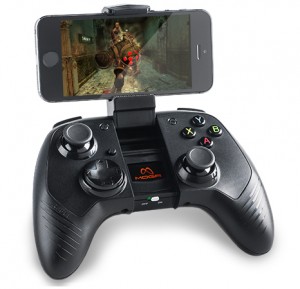 With the arm extended, you can very easily slide an iPhone or iPod touch into its clamp, and it stays there incredibly securely. Seriously, I tried shaking the Rebel all around with an iPhone attached and that sucker went nowhere. With an iPhone attached, the Rebel transforms into a more traditional gaming console like a Nintendo 3DS or even more closely to something like the Nvidia Shield. I can easily hold the entire setup as close to my face as is comfortable, lay back on the couch and play, sit upright and play, or whatever. It’s really nice having just one unit to worry about, rather than having my iOS device separate from the controller.
With the arm extended, you can very easily slide an iPhone or iPod touch into its clamp, and it stays there incredibly securely. Seriously, I tried shaking the Rebel all around with an iPhone attached and that sucker went nowhere. With an iPhone attached, the Rebel transforms into a more traditional gaming console like a Nintendo 3DS or even more closely to something like the Nvidia Shield. I can easily hold the entire setup as close to my face as is comfortable, lay back on the couch and play, sit upright and play, or whatever. It’s really nice having just one unit to worry about, rather than having my iOS device separate from the controller.
One drawback to the arm is that it only folds out to a certain point, which by eyeballing looks to be about a 45 degree angle. This is likely so that the controller won’t fall forwards when you set it down and it has the added weight of an iOS device in it. Now, I’m not saying I’d even want it to fold all the way back, but the point in which it stops feels just ever so slightly too forward for my taste. As a result, I sometimes find I’m kind of twisting the entire controller forward in order to get the best, head-on view of my iPhone screen. For the most part it’s never an issue, and even when it is, it’s the most minor of annoyances. But it still felt worth mentioning.
Another part of the experience, but not really due to the Rebel itself, is how well games implement their MFi controller support. A ton of games support them now, and almost all of them are an improved experience with physical controls. However, some games feature support that feels kind of half-baked. For instance, some games will dim the screen when using a controller since it thinks you’re not using the device due to not actually touching the touchscreen. Also, it’s really nice when a game actually integrates what buttons on the controller do in the game. Two good examples of this are Wayward Souls and GTA: San Andreas. When using the Rebel with those, there are actual graphical cues as to what each button on the controller does in game. You can also fully navigate menus with the controller, another area where some games don’t come through.
 These sort of minor issue will likely fade away as more MFi controllers become available and more games support them, but seeing as I’ve gone through literally dozens of MFi-supported games over the past week, you really start to notice the ones that do a great job with it and the ones that need some work. Again, that’s no fault of the Rebel controller itself, but feels worth mentioning as part of the overall experience of using an MFi controller.
These sort of minor issue will likely fade away as more MFi controllers become available and more games support them, but seeing as I’ve gone through literally dozens of MFi-supported games over the past week, you really start to notice the ones that do a great job with it and the ones that need some work. Again, that’s no fault of the Rebel controller itself, but feels worth mentioning as part of the overall experience of using an MFi controller.
A couple of other issues I wanted to touch on is battery life and AirPlay support. While the dream of many is to use an iOS device as a home console by magically beaming its output to a big flatscreen TV using AirPlay and an Apple TV, the experience is very hit and miss. This isn’t the fault of any of the MFi controllers, but more due to the AirPlay technology itself. Games can severely stutter and there can be a latency with the actions you’re performing and what you’re seeing on the TV. Again, this isn’t the fault of the controller itself. However, some games do work better than others, and if gaming through AirPlay is a big deal to you, you’ll likely be able to find the games that work best for that. Or, you can cut out the wireless portion and connect your iOS device directly to the TV via an HDMI cable and go that route. Either way, we’ll have to wait for Apple to massively improve AirPlay functionality before it becomes any sort of killer feature of having an MFi controller.
As for battery, the Rebel seems to hold up incredibly well in this area. The instruction booklet states it takes 6-8 hours to fully charge, though I just leave it plugged in overnight so I can’t say how long it takes exactly. However, once its fully charged it just seems to keep on going like that little Energizer bunny. Incredibly, I’m still on my first charge from a week ago, and I’ve been using this thing A LOT. I don’t know if the battery performance will diminish a lot over time, but for right now, it’s really, really good. Also, there’s a dedicated on/off button hidden under the fold-out arm, so when you know you won’t be using the Rebel you can simply switch it off to conserve battery. If you forget to do that though (which I’ve done many times already), the Rebel will automatically shut itself off when not used for a while, which is nice.
So, what’s the bottom line? Well, as fantastic as the Rebel is, it still suffers some of the same problems of other MFi controllers. Namely, the price. The Rebel would be considered one of the better 3rd-party controllers if you bought it for a console at around half the price, but it in no way feels like something that should cost 80 dollars. That’s not to say that it feels cheap or poorly built, but it feels too expensive compared to controllers available on other gaming platforms, especially first-party controllers which feel both higher quality than the Rebel and are much cheaper. I think pricing will always be a sore spot for MFi controllers, and I don’t necessarily think it’s the fault of the controller manufacturers themselves. It’s just the way things are in the Apple world.
That said, if you’ve already decided to part ways with that amount of money in exchange for an MFi controller, the Rebel is totally the one to get if you’re interested in a full-size option. It works beautifully as just a standalone controller with an iPad, but the real killer feature for me is the arm that allows you to attach an iPhone securely to the controller itself. With that, it’s like having a real portable gaming system complete with physical controls. This is a controller that I’ll actually be using in my everyday gaming, and it doesn’t feel like I have to jump through any hoops or deal with uncomfortable positioning to use it. Devices slide in and out of the arm so easily, and I’m really anxious to get my new iPhone 6 in there and test out what the controller is like with the larger screen.
Besides pricing, the only other drawbacks I found with the Rebel are its awkward d-pad and that the fold-out arm doesn’t quite go far enough back for my taste. Again, neither of these issues turned out to be major deal breakers, and the majority of the time they weren’t issues at all. But they’re still worth mentioning.
I don’t know if MFi controllers will ever take off like we all thought they would a year ago, but I do know that the MOGA Rebel is a great step in the right direction for making that happen. For those looking for an MFi controller, this is the most “must have" of the ones already available. That’s not saying a bunch, as what’s out there is pretty mediocre, but the Rebel is the first MFi controller that I actually look forward to using daily, which is saying something. Also worth considering is the huge list of MFi controllers that we saw during conventions this year, which are supposedly coming out sometime in the (near?) future. But if you feel like you’ve waited long enough, the Rebel is far and away the best MFi controller available right now. It’ll set you back $79.99 and is available through MOGA’s site , and should be available in Apple retail stores as well. If you end up getting one, definitely let us know what you think in the comments below.
